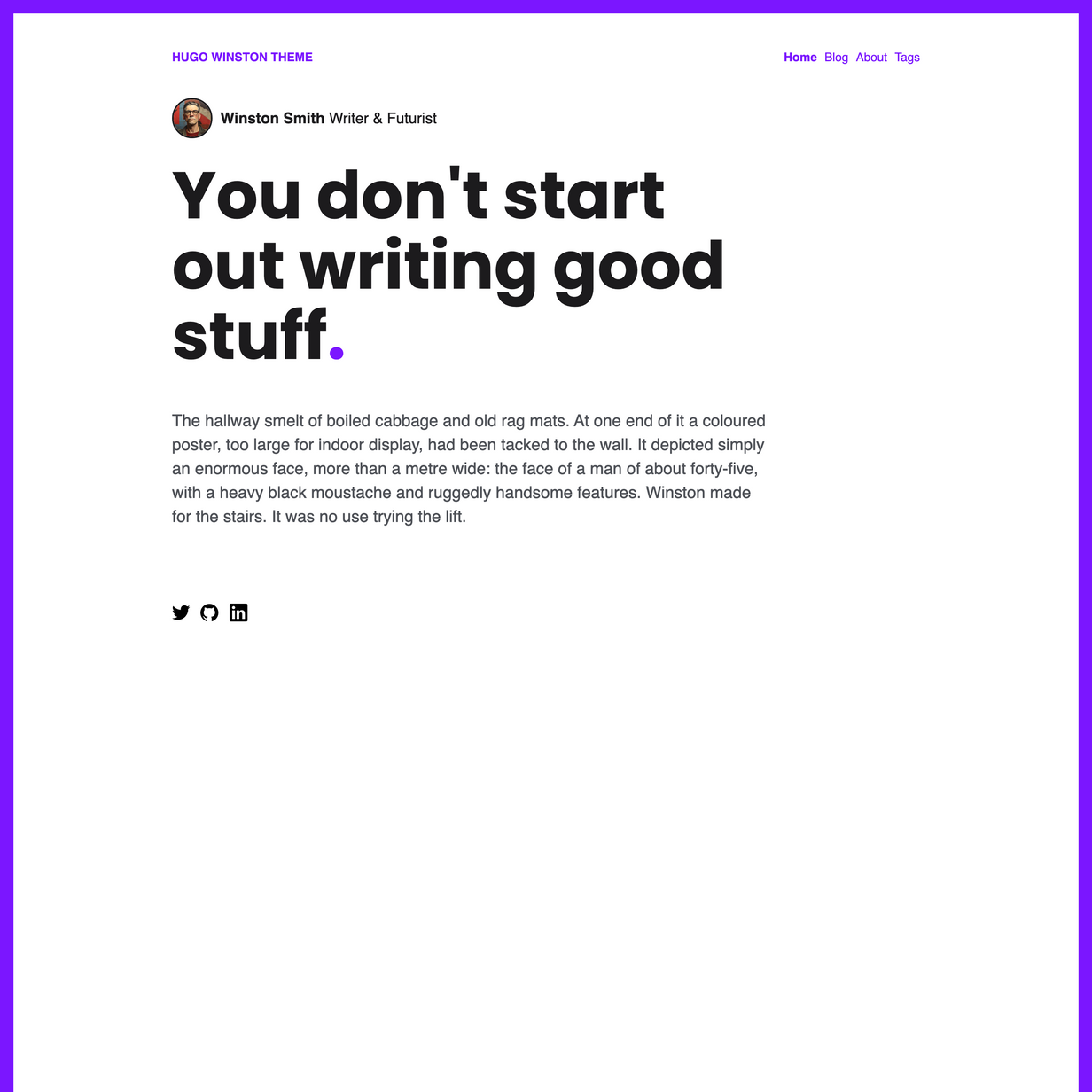Hugo Winston is a bold minimal blogging theme.
- Posts (Markdown)
- Basic Page (Markdown)
- SCSS (Hugo Pipelines)
- Responsive design
- 100/100 Google Lighthouse speed score
- 100/100 Google Lighthouse SEO score
- 100/100 Google Lighthouse accessibility score
- Google analytics configured in
config.toml - Configure GID using env variable HUGO_GOOGLE_ANALYTICS_ID, compatible with Netlify.
- Title, meta description and meta tags automatically generated for every page
- OG Meta data for Facebook and Twitter
- Semantic HTML document structure
To use this theme you will need to have Hugo installed. If you don't already have Hugo installed please follow the official installation guide
This theme uses Hugo Pipes to compile SCSS and minify assets. Please make sure you have the Hugo Extended version installed. If you are not using the extended version this theme will not not compile.
To check your version of Hugo, run:
hugo version
This will output the currently installed version of Hugo. Make sure you see /extended after the version number, for example Hugo Static Site Generator v0.51/extended darwin/amd64 BuildDate: unknown You do not need to use version v0.51 specifically, you can use any version of Hugo above 0.51. It just needs to have the /extended part
hugo new site mynewsite
This will create a fresh Hugo site in the folder mynewsite.
Clone this repo into the themes folder
cd mynewsite
git clone https://github.com/zerostaticthemes/hugo-winston-theme.git themes/hugo-winston-theme
Copy the entire contents of the mynewsite/themes/hugo-winston-theme/exampleSite/ folder to root folder of your Hugo site, ie mynewsite/
To copy the files using terminal, make sure you are still in the projects root, ie the mynewsite folder.
cp -a themes/hugo-winston-theme/exampleSite/. .
After you copy the config.toml into the root folder of your Hugo site you will need to update the baseURL, themesDir and theme values in mynewsite/config.toml
baseURL = "/"
themesDir = "themes"
theme = "hugo-winston-theme"
After installing the theme for the first time, generate the Hugo site.
You run this command from the root folder of your Hugo site ie mynewsite/
hugo
For local development run Hugo's built-in local server.
hugo server
Now enter localhost:1313 in the address bar of your browser.
// config.toml
[params]
google_analytics_id = ""
twitter_handle = "@zerostaticio"
showAuthorOnHomepage = true
showAuthorOnPosts = false
showPostsOnHomepage = false
addFrame = true
addDot = true
Add you google analytics ID to the config.toml
// config.toml
[params]
google_analytics_id="UA-132398315-1"
This theme includes a netlify.toml which is configured to deploy to Netlify from the exampleSite folder. See this discussion on how to deploy your site on Netlify from the exampleSite folder - https://discourse.gohugo.io/t/deploy-your-theme-to-netlify/15508
Most likely if you are deploying to Netlify and created a new Hugo site or added this theme to an existing Hugo site then you are not deploying from the exampleSite directory and you can delete the netlify.toml file.
If you fork or copy this theme the LICENSE file and the copyright notice on line 3 (where I am listed as the author) must not be changed. You cannot just replace the copyright line with your own name. Attribution in your README.md or on your site is also welcome but not required.
